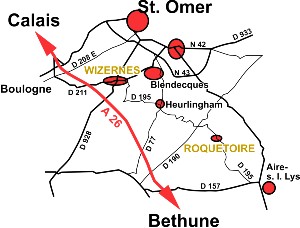
One very unique structure related to the Wizernes project is in the small French place of Roquetoire, about 8-9 km away from the small town Wizernes and southeast from St. Omer. In this fortress-like concrete structure (medium sized compared to other German works), there was established an ultramodern, ground-based, radio beam remote V2 guidance system. The system received the code name "Umspannwerk C" (transformer station C). This apparatus was conceived and built for guide-beam flight correction of the V2 rocket during launch. Thus, one can see the direct connection between the Wizernes and Roquetoire projects.
 The
Leitstrahlstellung radio beam at Roquetoire, for use specifically in conjunction
with the firing bunker at Wizernes, was the only application of this concept
put into action by the Germans. None of the other rocket-bunker projects
were designed to use radio beam guidance. The bunker would have provided
protection, support and supplies to the vehicles and crews operating the
Leitstrahl equipment and vehicles. It would have been a safe place for
storage and repair, and ease of deployment during operations. The use of
the beam system was so secret, that only the planners and personel at the
two facilities knew of its existance. It was shown that constant advances
by the Allies in the use of "jammers" to break the German beams, could
have easily countered the guidance signal. Even though the Leitstrahlstellung
radio beam operation would last only about a minute during a V2 launch
and any jamming attempts would have required a known frequency of the beam,
the Germans still kept this device top secret. In fact, the allies never
discovered this system.
The
Leitstrahlstellung radio beam at Roquetoire, for use specifically in conjunction
with the firing bunker at Wizernes, was the only application of this concept
put into action by the Germans. None of the other rocket-bunker projects
were designed to use radio beam guidance. The bunker would have provided
protection, support and supplies to the vehicles and crews operating the
Leitstrahl equipment and vehicles. It would have been a safe place for
storage and repair, and ease of deployment during operations. The use of
the beam system was so secret, that only the planners and personel at the
two facilities knew of its existance. It was shown that constant advances
by the Allies in the use of "jammers" to break the German beams, could
have easily countered the guidance signal. Even though the Leitstrahlstellung
radio beam operation would last only about a minute during a V2 launch
and any jamming attempts would have required a known frequency of the beam,
the Germans still kept this device top secret. In fact, the allies never
discovered this system.
To hit a target within a 250 meters radius and 250 km's away, the side deviation of the flightpath of the V2 had to be not bigger than 1:1.000, and a curve of some arc minutes. Deviations in the height corner of 45 degrees were of small influence but, the speed at burn stop had to be within 0.5 % exact. That is why, high criteria was required for the steering gear of the rocket. In practice, they could reach a corner of plus or minus 1 degree, so that, in a shooting distance of 250 km, at least 50% of the A4 fell in an line of 10 km wide. To enhance this they already started devoloping (during the first developing phase of the A4), the "Leitstrahl" and radio measurement to electronically adjust a V2 already in flight.
The development of the instruments was given to the navigations department of the firm "Lorenz". They delivered "Leitstrahl-(LS)-facheranlage Viktoria" appearing in Nov. of 1940 as a 500 watt adjusting transmitter for the UKW beaken. This transmitter had a frequency of 45 Mhz and was probably devoloped from a landing beaken. It was a "Phasedreiglieder" twice with a deflector contained a horizontal dipole antenna, that was set up at a distance of 8-15 km's behind the launchpad. One of the antennas was direct connected to the transmitter and the other was attached to a "drehkondensator" in a tastverhaltnis 1:1 and 30 times per minute changed in phase. You can see the opposing V2 rocket dipole attenna attached on later production V2 pictures, coming out of the trailing edge of the rocket fins. The plans for this bunker were drawn up in September of 1943.
Synchronous switching of the modulation tone was to take place between 5-7 kHz. Two fan-shaped signals, with different modulation tones, formed the beams of only 0.0125 degrees. These would overlap in places, resulting in an amplitude difference of the modulation of about 5%. The system had to be adjusted very exactly, since the strength of the main beam in relation to the inversly formed counter beam only amounted to 2 degrees.



















